Breastfeeding makes it so easy to feed your baby—no mixing formula required!—but there still might be times when you want to give your breastfed baby a bottle. Whether you’re returning to work, going on a long car trip, or letting your partner have the chance to feed the baby, it’s helpful to have bottles on hand. Even more important, though, is having bottles that breastfed babies will actually like.
Finding the right baby supplies can be time-consuming—just think of the last time you went into a baby supply store! Shelf after shelf of stuff that all looks similar makes it hard to decide which one is best. Having a lot of choices is great, but it can also be overwhelming. And breastfed babies have some special requirements for their bottles. To help you find the best bottles for your baby, we’ve reviewed the ones that complement breastfeeding the most.
- Features to Consider in Bottles for Breastfed Babies
- Top 10 Best Bottles for Breastfed Babies 2026
- 1. Best Overall Bottle for Breastfed Babies: Philips Avent Natural Baby Bottle
- 2. Best Premium Bottle for Breastfed Babies: Comotomo Baby Bottle
- 3. Best Budget Bottle for Breastfed Babies: NUK Simply Natural Baby Bottle
- 4. Parent Favorite Bottle for Breastfed Babies: Dr. Brown’s Options+ Wide-Neck Baby Bottle
- 5. Best Glass Bottle for Breastfed Babies: Philips Avent Natural Glass Baby Bottle
- 6. Tommee Tippee Closer to Nature Baby Bottle
- 7. Lansinoh Breastfeeding Bottles for Baby
- 8. Evenflo Feeding Premium Proflo Venting Plus Bottles
- 9. MAM Easy Start Anti-Colic Bottle
- 10. Munchkin Latch Anti-Colic Baby Bottle
- Guide to Buying the Best Bottles for Breastfed Babies for 2026
- Final Thoughts
Features to Consider in Bottles for Breastfed Babies
Material
The vast majority of bottles are made of plastic, but we found two other options if you’d rather avoid using plastic for your baby.
Silicone
Silicone is widely used for nipples since it’s soft, flexible, and non-toxic. Because of silicone’s many advantages, a few brands have decided to use it for their bottles, too. The material is more expensive, but it’s extremely heat-resistant, so you don’t have to worry about boiling it or sterilizing it in the microwave.
It’s also stain-resistant. You wouldn’t think milk would stain, but it does tend to yellow bottles over time. It can also leave behind a sour milk smell. Silicone bottles resist this. Plus, they’re soft and squishy for your little one’s hands.
Glass
You might think glass and babies don’t mix, but glass bottles now are made from borosilicate glass. This type of glass is shock and temperature-resistant, so they don’t break easily. Many glass bottles also include a silicone sleeve to further protect it from accidental drops.
Glass is also completely non-toxic, stain-resistant, and resists yellowing. If you’ve replaced all your plastic food storage containers in favor of glass, then you know glass does a better job of staying clean and smell-free. The same goes for glass bottles.
Like silicone, though, glass bottles tend to be more expensive. And even though they are made from strong glass, they can still break if you drop them on a hard surface.
Plastic
Plastic is the most common bottle material for good reason. It’s inexpensive, durable, and long-lasting. Many plastic bottles even convert to sippy cups so you can make your dollar stretch even further.
However, some parents wish to avoid plastic as much as possible because of the possibility of harmful chemicals leaching into food and drinks. Phthalate is a common polymer in plastic, but it’s one of the ones that should be avoided. BPA is another common chemical in plastic that almost all bottle companies avoid. All the bottles on our list are BPA-free.
Nipple Design
The nipple is arguably the most important part of the bottle—at least to your breastfed baby. The closer the nipple design is to nature, the more likely your breastfed baby will be to accept it.
Closer to Nature
Look for nipples with a wide mound at the base to encourage a good latch. The tip of the nipple should also closely resemble a mom’s real nipple to make it easier for your breastfed baby to go back and forth from breast to bottle.
Soft and Flexible
Real nipples are soft and flexible, so this is what your baby will be most used to. However, the nipple shouldn’t be so soft that it collapses. A collapsing nipple is frustrating, and it might make your baby less likely to accept the bottle.
Milk Flow
There should be different options for milk flow from the nipples. Depending on your baby’s age and feeding style, you may need a slow flow, medium flow, or fast flow nipple. Almost all bottles give you different nipple flow options, but some will have four or more options. This makes it easier for you to find the best one for your baby.
Anti-Colic Designs
Breastfeeding babies don’t suck down a lot of air when they nurse. Bottle feeding, on the other hand, can cause babies to gulp down air along with their milk. This can lead to gassiness, tummy discomfort, or even colic. The last thing you want is for your bottle to make your life harder by causing your baby discomfort! To combat this, many bottles have anti-colic design features.
In general, there are two different places for anti-colic vents: on the nipple or internally.
- Nipple Anti-Colic Vents. When the vents are on the nipple, you don’t have to worry about dealing with extra bottle parts to wash and sterilize. Depending on where the vent is placed, though, your baby’s lips might cover it while feeding, which would make it less effective.
- Internal Anti-Colic Valves. These valves are a separate part that you put inside the bottle to filter out the foam and bubbles from the milk. They vary in design, but they’re typically more effective than just a nipple vent. The disadvantage to internal valves is that they’re more difficult to clean, and you have more bottle parts to keep up with.
Easy to Clean
Baby bottles need to be cleaned and sterilized after every use, so it’ll make your life much easier if the bottle is easy to clean. We’re going to be honest with you, though. You can try and pick a bottle that’s easy to clean, but ultimately, it’s going to come down to which one your baby likes. And your baby might decide to like the bottle that has ten different parts. This is especially true if your baby has colic and needs a bottle with an internal valve.
Top 10 Best Bottles for Breastfed Babies 2026
1. Best Overall Bottle for Breastfed Babies: Philips Avent Natural Baby Bottle
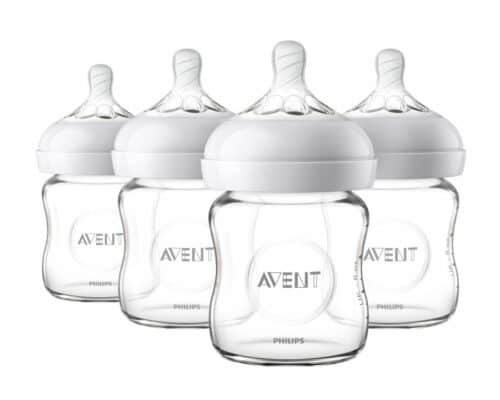
Editor’s Rating:
Quick Facts
- Material: Plastic (BPA-free)
- Natural-looking nipple: Yes
- Anti-colic feature: Vented nipple
- Easy to clean: Yes
Review
One of the most important parts of the bottle for breastfed babies is the nipple, and the Philips Avent Natural Baby Bottle has an ideal design. It lives up to its name with one that’s natural-looking as well as soft and flexible.
The Bottle
The Philips Avent Natural Baby Bottle features anti-colic vents to reduce the amount of air your baby sucks in. This is important for babies who are used to the breast, where gassiness isn’t a problem. You don’t want the bottle to be the reason your baby has painful gas!
Some bottles like Dr. Brown’s have many parts to clean, but the Philips Avent Natural Baby Bottle only has three: the bottle, the nipple ring, and the nipple. The bottle has a wide opening so you can easily get a brush inside to clean it.
Another great feature for this bottle is that you can mix and match different parts so that it changes with your growing baby. Aside from the different nipples, you can buy handles for the bottle so your baby can easily hold it. It can also transform into a sippy cup to take your baby through the toddler years. This makes the Philip Avent bottle cost-effective and reduces the number of baby and toddler supplies cluttering up your cabinet.
The Nipple
The Philips Avent Natural Baby Bottle features a wide mound at the base of the nipple, and it has a soft texture to mimic the breast. Hate dealing with collapsing nipples? We do, too. The Philips Avent nipples have a spiral design to keep them from collapsing even though they’re soft and flexible.
There are also lots of milk-flow options for the nipples. You can choose among six different nipple flow rates to find the best one for your baby. Each nipple has a different number of holes to control the flow of milk.
- First flow is the slowest option
- 0+ months with one hole
- 1+ months with two holes
- 3+ months with three holes
- 6+ months with four holes
- A variable-rate flow for 3+ months
Verdict
Overall, this is a great bottle with lots of options for milk flow rates and a natural look and feel to the nipple. There is one thing to be aware of if you decide to purchase, though. The bottle can leak if not assembled properly, so be sure you screw the nipple ring on tightly. The faster milk-flow nipples may also leak but putting a bib on your baby will prevent it from getting on the baby’s clothes.
Pros
- Soft, flexible nipple with a wide mound to mimic the breast
- Six different nipple milk-flow rates
- Converts from bottle to sippy cup
- Anti-colic vents
- Easy to clean and sterilize
Cons
- Can leak
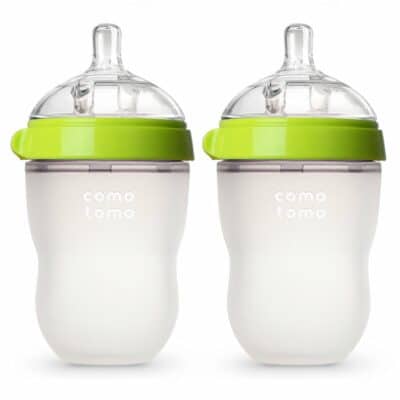
Editor’s Rating:
Quick Facts
- Material: Silicone
- Natural-looking nipple: Yes
- Anti-colic feature: Vented nipple
- Easy to clean: Yes
Review
The Comotomo Baby Bottle has some design features that make it unique and ideal for breastfed babies.
The Bottle
While most other bottles are made of plastic, the Comotomo is made of food-grade silicone. Not only is silicone soft for babies who can hold their own bottle, but it also won’t leach chemicals into your milk, even at high temperatures. Almost all plastic bottles are BPA-free, but with silicone, you don’t have to worry about other harmful chemicals found in plastic.
The silicone also allows you to sterilize these bottles with boiling water, microwaves, dishwashers, and bottle sterilizers without them yellowing or staining. Attractive-looking bottles might not seem like a big deal, but those stains mean that old milk is coating the inside. Neither you nor your baby will appreciate smelling sour milk!
The Comotomo bottles are great for your baby, but they also have some features that parents love. Thanks to the wide opening, they are easy to clean. Many bottles are narrow and require special bottle-cleaning brushes to get them clean, which means you need even more baby equipment in your house! The wide opening also allows these bottles to dry quickly. And while other bottles have lots of small parts to keep up with, these only have three: the nipple, the nipple ring, and the bottle.
The Nipple
The material the bottle is made of is important, but even more essential is the nipple. The Comotomo nipple is designed to make it easy for your breastfed baby to latch. It has a wide mound that mimics the breast and a more natural-looking nipple. The Comotomo bottle also has four different nipple options so you can choose the best one for your baby.
- 0-3 months with one hole (slow flow)
- 3-6 months with two holes (medium flow)
- 6+ months with three holes (fast flow)
- 3+ months with a y-cut hole (variable flow)
To help prevent your baby from sucking in too much air, the Comotomo nipple has two anti-colic vents. These vents allow air into the bottle for good milk flow, but not back into your baby’s mouth. The last thing you want to deal with is a gassy or colicky baby!
Verdict
Even with so many other bottles to choose from, the Comotomo is a clear winner. It’s not the cheapest option, but it’s worth the price if it makes your baby’s transition from the breast to the bottle (and back again) easier.
The one disadvantage to a bottle made of silicone is that its heat-resistant properties make it slow to heat up. When it’s 2 AM, and you’re trying to heat a bottle to feed a hungry baby, it’ll feel like it’s taking an eternity for the milk to warm inside the silicone. If you can work around this inconvenience, though, the great design features of this bottle are worth it.
Pros
- Made of food-grade silicone
- Most natural-looking nipple design
- Four different types of nipples with variable milk flow rates
- Easy to clean and sterilize
- Anti-colic vents prevent your baby from sucking in too much air
Cons
- Takes longer to heat up in a bottle warmer
3. Best Budget Bottle for Breastfed Babies: NUK Simply Natural Baby Bottle
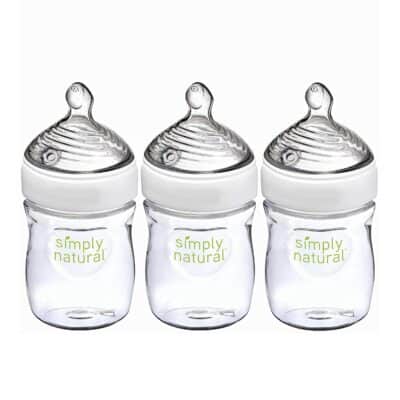
Editor’s Rating:
Quick Facts
- Material: Plastic (BPA-free)
- Natural-looking nipple: Yes
- Anti-colic feature: Vented nipple
- Easy to clean: Yes
Review
All those baby supplies can really add up, but the NUK Simply Natural Baby Bottles are extremely budget-friendly. Just because they’re inexpensive doesn’t mean they’re cheap.
The Bottle
The bottles are made from a thick, high-quality plastic that resists stains and is very durable. The plastic is BPA-free and washes really well, maintaining its crystal-clear appearance even after multiple runs in the dishwasher.
The Nipple
More importantly, though, are the way the nipples are made to mimic breasts. There is a scooped cavity in the tip of the nipple to allow your baby’s tongue and jaw to move more naturally. The silicone nipples are also soft and flexible for a more natural feel.
What really sets these bottles apart is the fact that the nipples have more holes than any other bottle brand. The fast-flow nipples have nine, which is closer to the number that women have. The slow-flow nipples have three holes as opposed to the usual one, but the milk doesn’t leak out even when you turn the bottle upside down and shake it. The milk will only flow when your baby starts to suck—just like breastfeeding.
The nipples also feature anti-colic vents to allow your baby to suck in liquid and not air. Having the vent on the nipple is an advantage because then you don’t have to deal with any additional bottle parts.
Verdict
Having more nipple holes is closer to nature, but some babies may struggle with the flow of milk. This is especially true when moving from a slow-flow nipple, which has three holes, and a medium-flow nipple, which has six. This is double the number of holes, and while your baby might be ready for a faster flow than the first nipple, your baby may not be ready for that fast of a flow.
Overall, though, these are great bottles for everyone—not just parents on a budget.
Pros
- Budget-friendly
- More nipple holes than any other bottle brand
- Nipples designed to mimic nature
- Stain-resistant and durable
- Anti-colic vents
Cons
- Medium-flow nipples may be too fast for some babies
4. Parent Favorite Bottle for Breastfed Babies: Dr. Brown’s Options+ Wide-Neck Baby Bottle
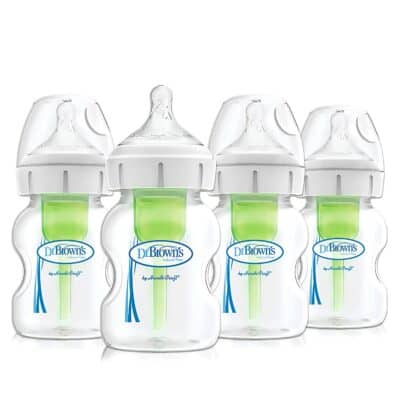
Editor’s Rating:
Quick Facts
- Material: Plastic (BPA-free)
- Natural-looking nipple: Yes
- Anti-colic feature: Vented nipple and internal vented system
- Easy to clean: No
Review
For bottles for breastfed babies, you can move this text from first under the section The Bottle “Dr. Brown’s bottles have actually been clinically proven to reduce colic thanks to their internal vent system and vented nipple. If you have a gassy baby or a baby who already suffers from colic, then these bottles can be a lifesaver” to the Review. I have made that change in this file for you so it’s clearer.
The Bottle
Dr. Brown’s bottles have actually been clinically proven to reduce colic thanks to their internal vent system and vented nipple. If you have a gassy baby or a baby who already suffers from colic, then these bottles can be a lifesaver.
The original Dr. Brown’s bottles are slim and narrow, but the Options+ have wide necks for easy cleaning. This bottle line is called “Options” because you can remove the internal vent system and just use the one on the nipple if your baby isn’t prone to excessive gas or colic. This saves you from having lots of extra parts to clean, so it’s a nice feature to have.
The Nipple
The nipples are made of silicone to make them soft and flexible, and they have a wide mound at the base to help your baby latch easily. There are six different nipple speeds:
- Preemie for premature babies or babies in need of the slowest flow
- Slow flow (level one)
- Medium flow (level two)
- Medium-fast flow (level three)
- Fast flow (level four)
- Fast flow/adjustable flow (Y-cut)
Verdict
Dr. Brown’s is a trusted brand for colicky babies, and the Options+ bottles are great if your baby likes Dr. Brown’s nipples but doesn’t need the internal vent system. If you do need to use the internal vent system, though, having those extra parts to keep track of and clean can be annoying. These bottles can also leak with the faster-flow nipples, especially when you use the storage caps. This can result in milk pooling in the storage cap if the bottle gets turned upside down.
Pros
- Anti-colic vents on the nipple and internally
- Clinically proven to reduce colic
- Silicone nipple is soft, flexible, and has a wide mound for easy latching
- Six different flow rates for the nipples
Cons
- More parts to clean
- Can leak
5. Best Glass Bottle for Breastfed Babies: Philips Avent Natural Glass Baby Bottle
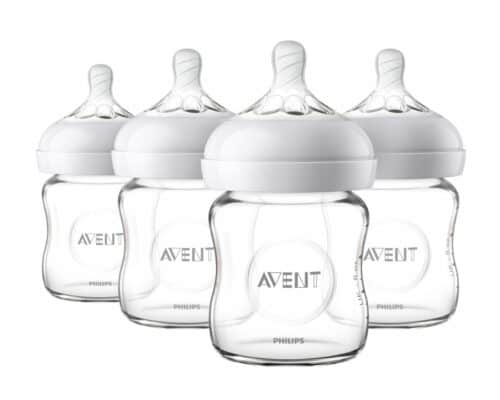
Editor’s Rating:
Quick Facts
- Material: Glass
- Natural-looking nipple: Yes
- Anti-colic feature: Vented nipple
- Easy to clean: Yes
Review
The Philips Avent Natural Glass bottles are on our list for the same reasons the plastic Philips Avent bottles are: they make it easy for your breastfed baby to latch, and they have an effective anti-colic design. The only difference, of course, is that these are made of glass.
The Bottle
Having glass bottles may seem old-fashioned, but they have so many advantages. For one thing, glass doesn’t yellow or discolor. No matter how well you clean your plastic bottles, over time, that sour milk smell won’t go away. Plastic bottles are typically BPA-free, but the American Pediatric Association has recommended that we limit plastic exposure in children as much as possible.
One concern with glass is that the bottles might break easily or shatter when exposed to high heat, but these bottles are made of borosilicate glass. Borosilicate glass is heat and thermal shock resistant, which means you can keep it cold in the refrigerator and quickly heat it up without it shattering.
The Nipple
Parents can use the same natural-looking nipples as the plastic bottle version. The nipples have wide mounds that make it easy for breastfeeding babies to latch. They also feature six different milk flow rates, from slow flow to fast.
Verdict
The more expensive material means these bottles are on the pricier side, but that might be worth it to have bottles that don’t stain, discolor, or leach harmful chemicals. And although these bottles are made from durable borosilicate glass, that doesn’t mean they’ll never break. If you drop them on a hard surface, they will break, leaving you with a big mess to clean up. Also, unlike the plastic version, these bottles don’t convert to sippy cups because you wouldn’t want your toddler running around with glass.
Pros
- Soft, flexible nipple with a wide mound to mimic the breast
- Six different nipple milk-flow rates
- No discoloring or staining
- Anti-colic vents
- Easy to clean and sterilize
Cons
- Glass can break
- Cannot convert to sippy cups
6. Tommee Tippee Closer to Nature Baby Bottle
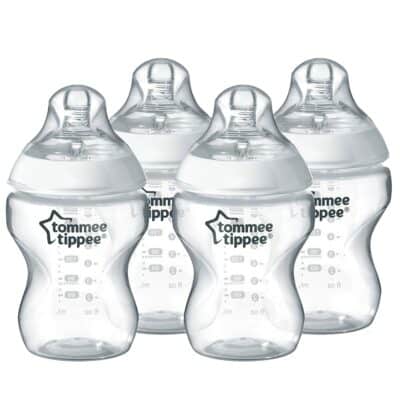
Editor’s Rating:
Quick Facts
- Material: Plastic (BPA-free and phthalate-free)
- Natural-looking nipple: Yes
- Anti-colic feature: Vented nipple
- Easy to clean: Yes
Review
The Tommee Tippee Closer to Nature Baby Bottle has features that make it easy for a breastfed baby to switch from breast to bottle and back. This is largely thanks to its silicone nipple that’s made to look and feel natural.
The Bottle
The Tommee Tippee Closer to Nature Baby Bottles have wide necks and only a few parts, so they’re easy to clean. This is great for parents who don’t want to keep up with small bottle parts and special bottle-cleaning brushes. The bottles are also BPA-free and phthalate-free, so you don’t have to worry about harmful chemicals leaching into your baby’s milk.
The Nipple
According to Tommee Tippee’s research survey, their bottle’s nipple has a high rate of acceptance from babies. The survey found 92% of babies accepted this bottle’s nipple within the first three tries. We weren’t able to independently verify these results, but the Tommee Tippee brand has been a favorite of breastfeeding parents for years.
The nipples also have an anti-colic vent that quickly and easily removes the extra air from the bottle so your baby doesn’t swallow it. The nipples feature three different flow rates: slow, medium, and fast.
Verdict
The Tommee Tippee Closer to Nature is similar to the Philips Avent bottles, so if you’re considering which of these to choose, it will probably come down to which nipple your baby prefers. Don’t worry, your baby will (enthusiastically) let you know!
We found that the slow flow nipples on these bottles are still fast. If you turn the bottle upside down, milk drips out. This means that your baby doesn’t have to work as hard to get the milk from the bottle. Breastfed babies are used to working hard to get their milk, so the comparatively faster flow might be overwhelming for small babies.
Pros
- Flexible nipple that’s made to look and feel natural
- Anti-colic vent built into the nipple
- Easy to clean
- BPA-free and phthalate-free
Cons
- Slow flow nipples are still pretty fast
- Only three flow rate options
7. Lansinoh Breastfeeding Bottles for Baby
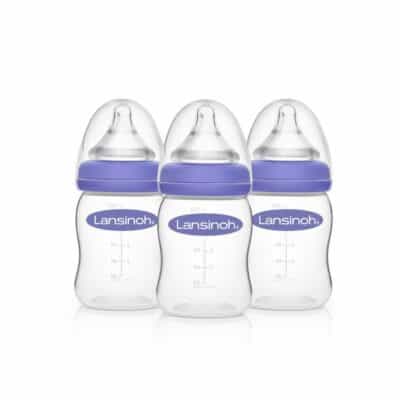
Editor’s Rating:
Quick Facts
- Material: Plastic (BPA-free)
- Natural-looking nipple: Yes
- Anti-colic feature: Vented nipple
- Easy to clean: Yes
Review
Lansinoh is a trusted breastfeeding brand with lots of helpful products, so it should be no surprise the Lansinoh Breastfeeding Bottles made our list.
The Bottle
These bottles are fully compatible with Lansinoh breast pumps without an adaptor. You can pump milk directly into the bottles and store them in the refrigerator or freezer, which saves you from having to use extra storage containers. Always a plus when space is tight!
The bottles also have wide openings to make them easy to clean. They only have three parts to keep up with: the nipple, the nipple ring, and the bottle.
The Nipple
The nipples on these bottles are specifically designed to encourage a good latch and to reduce nipple confusion. Nipple confusion is always a concern for breastfeeding moms because the fear is the baby will end up preferring a bottle over the breast. This bottle is designed to make it easy for your baby to go back and forth.
The nipples also feature an anti-colic vent so you don’t have to deal with any extra bottle parts to clean. However, the vent is placed in a way that your baby’s lips may cover it while feeding. This could cause the vent to be less effective.
Verdict
The Lansinoh Breastfeeding Bottles work well for ensuring your baby has a good latch, and the brand puts a lot of effort into researching the best products for breastfeeding. If you have other Lansinoh products, like the breast pump, then these bottles might save you the trouble of buying lots of other milk storage supplies.
If you decide to purchase these bottles, then you should know that they come with size 2 nipples, which are actually slow flow. Lansinoh has their nipples labeled confusingly as slow flow is called 2S, medium flow is called 3M, and fast flow is 4L. The slow flow nipples are also not very slow. If you hold the bottle upside down, milk drips out. This can not only result in leaks, but it can also be overwhelming for very small babies.
Pros
- Compatible with Lansinoh breast pumps
- Anti-colic vent in the nipple
- Wide mouth bottle
- BPA-free
Cons
- Slow flow nipples are too fast
- Anti-colic vent can be covered by baby’s lips which might reduce its effectiveness
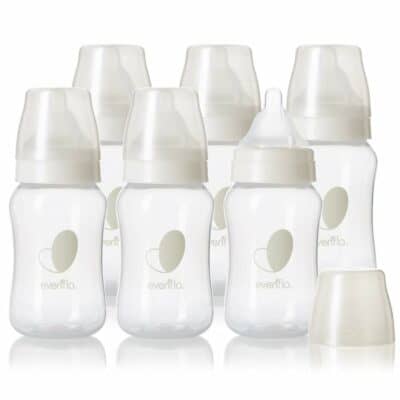
Editor’s Rating:
Quick Facts
- Material: Plastic (free of BPA, phthalates, PVC, and polycarbonate)
- Natural-looking nipple: No
- Anti-colic feature: Vented nipple
- Easy to clean: Yes
Review
The Evenflo Feeding Premium Proflo bottles are like the Lansinoh bottles in that you can use a breast pump with these bottles. However, you have to buy an adaptor that’s sold separately.
The Bottle
The bottles are made of plastic, but they are FDA food-grade. Evenflo also assures parents that the bottles are free of BPA, phthalates, PVC, and polycarbonate. Since these are the major chemical offenders that the American Pediatric Association recommends avoiding, it should give you peace of mind to know you can safely heat and sterilize these bottles.
The Nipple
The nipples on these bottles aren’t the most natural-looking, but the wide base does allow for a good latch. The short nipple is also good for babies with a strong gag reflex.
The bottles include slow-flow nipples, and they are truly slow. This is great for very young babies or for breastfed babies just starting on a bottle, but it may be frustrating for other babies. Like everything else, your baby will have the final say!
The anti-colic vent is located on the nipple, which means there are fewer parts to the bottle to wash and keep track of. Compared to other brands, though, the vent isn’t as effective at controlling colic symptoms.
Verdict
The Evenflo Feeding Premium Proflo is a great bottle for babies who need a slow flow nipple that won’t drip milk before the baby has a chance to suck. Other bottles on the market have a more natural-looking nipple, and the anti-colic vent leaves a lot to be desired. If you have a baby with a lot of gas or already suffering from colic, this might not be the best bottle.
Pros
- Short nipple is good for babies with a strong gag reflex
- Can pump directly into the bottle with an adaptor
- Anti-colic vent on nipple
- FDA food-grade plastic
Cons
- Very slow flow may frustrate some babies
- Anti-colic vent not as effective as other brands
9. MAM Easy Start Anti-Colic Bottle
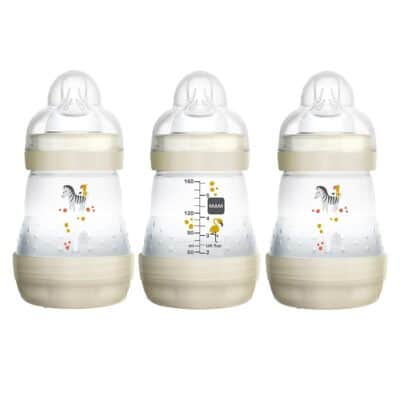
Editor’s Rating:
Quick Facts
- Material: Plastic (BPA and BPS-free)
- Natural-looking nipple: No
- Anti-colic feature: Vented base
- Easy to clean: No
Review
What sets the MAM Easy Start Anti-Colic Bottle apart from its competitors is its uniquely-designed vented base.
The Bottle
The anti-colic feature of the MAM Easy Start is a vented base that you screw onto the bottom of the bottle. It’s designed to regulate pressure and reduce foam and bubbles in your baby’s milk. It works well but having that extra part on your baby’s bottle can cause problems. For one thing, it’s another part to clean. There’s also a silicone ring that you have to put on top of the base before screwing it onto the bottle. If you forget the ring—say, in the middle of the night—the milk will leak out everywhere. Very frustrating.
These bottles are BPA and BPS-free, so you don’t have to worry about those particular chemicals when it comes to feeding your baby.
The Nipple
The silicone nipple has an orthodontic design to fit properly in your baby’s mouth. It doesn’t have the wide mound at its base like other brands, and the nipple doesn’t have as much of a natural look to it. Market research done by MAM found that 94% of babies accepted this nipple. We weren’t able to independently confirm the survey results, but MAM provides the survey dates and numbers on their website.
The bottles come with a size 1 nipple, but this may be too fast for your breastfed baby. Thankfully, MAM also has a size 0 slow-flow nipple that your baby may like better. The nipples go up to size 3, which is the fastest flow.
Verdict
MAM nipples have a high rate of acceptance from babies, so if you have a picky baby, then this might be a good bottle to try. Since the nipple has an orthodontic design, it’s made to support your baby’s jaw development. For parents, though, this might not be your favorite bottle. They take longer to clean thanks to all the small parts. The wide, thick base also makes these bottles take longer in a bottle warmer, and every second counts when you have a hungry, screaming baby!
Pros
- High acceptance of nipple
- Nipples have four different flow rates
- Vented base helps reduce colic
Cons
- More parts to the bottles
- Nipples aren’t as natural-looking as other brands
- No wide mound at the base of the nipple to mimic the breast
10. Munchkin Latch Anti-Colic Baby Bottle
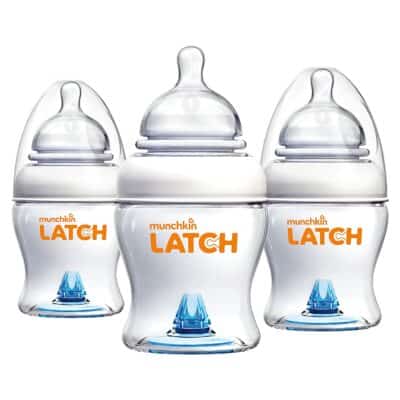
Editor’s Rating:
Quick Facts
- Material: Plastic (BPA-free)
- Natural-looking nipple: Yes
- Anti-colic feature: Internal valve
- Easy to clean: No
Review
The Munchkin Latch Anti-Colic Baby Bottle is a great choice if your baby wants to have more control over the flow of milk. The nipple’s unique design mimics breastfeeding and makes it easy for a breastfed baby to get the hang of bottle feeding.
The Bottle
The Munchkin Latch Anti-Colic Baby Bottle has an internal anti-colic valve to keep air from building up inside. This keeps your baby from gulping down too much air during a feed. This valve is problematic, though, in that it makes the bottle hard to clean. It’s a small part that requires a special brush, and it’s another bottle part to keep up with.
Another great feature is that you can connect this bottle directly to your breast pump. However, you have to purchase a separate adaptor.
The Nipple
This bottle is unique in that the nipple allows the baby to control the milk flow by applying more pressure to the base of the nipple. The nipple is flexible and has a pumping action to it. This is similar to how breastfeeding works and makes it easier for breastfed babies to transition to a bottle.
The soft nipple also has a tendency to collapse, which is understandably frustrating for your baby. The nipple ring is difficult to secure, and it can cause the bottle to leak. The last thing you want is wasted milk!
Verdict
Your baby might appreciate the similarity of the nipple to breastfeeding, but you might not appreciate having to clean extra bottle parts or deal with a leaky bottle.
Pros
- Can purchase an adaptor separately to connect it directly to your breast pump
- Flexible nipple that allows the baby to control the flow
- Overall similarity to breastfeeding
Cons
- Nipple collapses
- Leaks
- Valve at the bottom of the bottle is difficult to clean and is one more part to deal with
Guide to Buying the Best Bottles for Breastfed Babies for 2026
Babies may be small and helpless, but they’re born opinionated. Breastfed babies, who are used to being fed naturally at the breast, are the most opinionated babies of all. You may think you’ve found the best bottle for your baby, but ultimately, it’ll come down to which bottle your baby will accept.
If this is your baby’s first time taking a bottle, then we recommend buying just one bottle at a time. Give the bottle to your baby three times, and if your baby completely refuses each time, then you can try a different brand. You want to try it out more than one time, though, because it’s new to your baby. It might take your baby a few tries to get the hang of it, and your baby might end up liking the bottle after all.
There are a few other things to be aware of when it comes to buying the best bottles for breastfed babies. We’ll review each of them below.
Nipple Confusion
One of the biggest concerns when giving your breastfed baby a bottle is that it might cause nipple confusion. This is really a catch-all term for anything that might go wrong with switching from breastfeeding to the bottle and back again.
A lot of research has been done to try and explain exactly what we all mean by nipple confusion. In general, it means either your baby tries to suck at the breast the same way they do from a bottle, or they refuse to take a bottle or breastfeed at all.
For breastfeeding moms, the greatest fear is that their babies will learn to prefer a bottle over the breast and refuse to breastfeed anymore. This is why it’s so important to find a bottle that allows your baby to feed in a similar way to breastfeeding.
Differences between Breastfeeding and Bottle Feeding
Breastfeeding takes more effort from a baby than bottle feeding does. To understand why more natural-looking artificial nipples are best for breastfed babies, it’s helpful to look at the differences between breastfeeding and bottle feeding according to a research study:
- Babies have to suck much harder on the breast than a bottle. This is because a natural nipple has many small holes where milk comes from, and a bottle only has a few.
- A natural nipple is more flexible and stretches further than an artificial nipple.
- A natural nipple is held much farther back in a baby’s mouth than an artificial nipple.
- Babies tend to swallow more air with bottles.
- Babies can typically drink milk faster from a bottle.
The closer bottle feeding is to breastfeeding, the more likely your baby will be to accept the bottle and still be able to breastfeed. With a bottle that more closely resembles nature, you can hopefully avoid nipple confusion.
Therefore, You Should Look For a Bottle That:
- Has numerous nipple holes like a natural nipple
- Is flexible and stretchy like a natural nipple
- Has a valve in place to prevent excess air from being swallowed
- Makes it harder for babies to gulp down all the milk in the bottle in just a few minutes
How to Avoid Nipple Confusion
It can be scary to think your baby might develop nipple confusion, but there are many things you can do to avoid it. Before you introduce the bottle, make sure your baby has the hang of breastfeeding with no issues latching. Somewhere between 4 and 6 weeks is ideal to introduce the bottle.
When you first introduce the bottle, try having others give your baby the bottle like your partner or a grandparent. This way, your baby will associate the bottle with other loved ones and breastfeeding with mom. At the same time, you want to keep breastfeeding as much as possible.
You should try different bottles a few times until you find one your baby likes. Make sure to choose a bottle that’s made for breastfed babies.
How to Choose the Nipple Flow Level
The first thing to know about choosing a nipple flow level for your baby is that you don’t have to follow the month indicators (like 3 months, 6 months, etc). Some babies are happy with a slow flow nipple the entire time they take a bottle; whereas, some will want a faster flow right away. So how do you know which one your baby prefers?
Your baby might need a faster nipple flow if:
- They take too long to finish a bottle
- They act fussy and irritable
- They fall asleep before finishing the bottle
- They cry or refuse the bottle soon after starting to feed
Your baby might need a slower nipple flow if:
- They choke, sputter, or gag on the milk
- They gulp the milk or swallow hard
- Milk comes out the side of your baby’s mouth
- They cry or refuse the bottle
A variable flow rate nipple can also help in either situation because it gives your baby more control over the milk flow rate. Some bottles are also known for having either a really slow flow nipple or faster flows. Evenflo Proflo Bottles have slow flow nipples that are very slow and won’t drip. Lansinoh bottles are known for having faster nipple flow rates, even for their slow flow nipples.
Another option is to try bottles like Philips Avent bottles or Dr. Brown’s Options+ that offer many nipple flow rates.
Bottle Size Options
Newborns have small stomachs with only a few ounces of capacity, so smaller 4-ounce bottles are best to prevent your milk from going to waste. As your baby grows, you’ll want the option to move up to 8-ounce bottles so you’re not having to fix multiple bottles at one time. Almost all the bottles on our list come in 10 to 11-ounce sizes, which will take your baby from infancy to toddlerhood. We recommend always starting with a smaller size until you’re sure your baby will accept that particular bottle.
Final Thoughts
By now, you’ve no doubt realized that it’s your baby who will make the final decision on which bottle you choose. For such a small person, babies are incredibly opinionated!
However, researching the best bottles for breastfed babies makes it more likely that you’ll find one that your baby will accept. By trying out bottles that closely resemble nature, are easy to clean, and won’t cause colic, you’ll hopefully find the perfect one for your baby.
